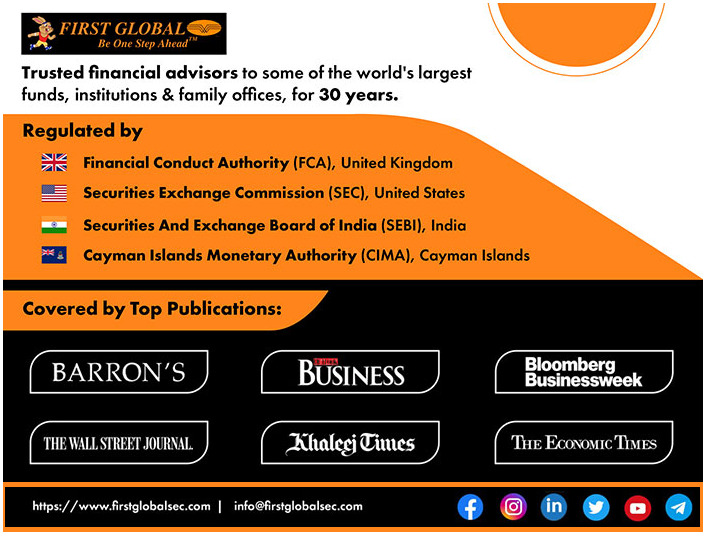One of the key metrics we, at First Global, look for, when building our Portfolios, is: how correlated are our Positions. Meaning: do we have many stocks in the overall same category, eg, US NASDAQ, which then means that even if we have 25 such stocks, in effect, because of the very high correlation between them (95-99%), we actually own just one stock! And that's hugely risky, even though on paper, we own a diversified basket of 25 stocks.
Therefore, central to building a durable investment strategy is to constantly build several streams of uncorrelated- low correlated assets, that still directionally beat the market, and yet have very low chance of falling together. Think, JSW Steel and IndiaMART, together. Get the drift?
And this is possible because of a wide dispersion in asset class returns, even at the very same time.
Let's dive deeper.
Cross-asset investing is a strategy that is basically built on the premise that the correlation between various asset classes such as Equities, Fixed Income, Commodities and Currencies remains low enough most of the time to allow for investors to benefit from diversification. Some ultra- sophisticated investment strategies, driven by vast computing power, tend to be built around this assumption and thus, end up applying the famous Markowitz Model in their cross-asset portfolios.
In finance, the Markowitz model - put forward by Harry Markowitz in 1952 - is a portfolio optimization model that assists in the selection of the most efficient portfolio by analyzing various possible portfolios of the given securities/assets. Here, by choosing securities that do not 'move' exactly together (think low correlation), the HM model shows investors how to reduce their risk (defined by volatility here).
But, does this actually hold true when we look at the data?
Below we shall look at the performance of Equities (major markets), Fixed Income & Commodities across the following years: 1997, 1998, 2000, 2001, 2002, 2003 & 2008. The return dispersion is quite eye-opening.
The year 1997 was something Investors across the world couldn't have imagined. Asian " tiger nations" were red hot. The crisis started in Thailand on 2 July, with the financial collapse of the Thai baht after the Thai government was forced to float the baht due to lack of foreign currency to support its currency peg to the U.S. dollar. The contagion spread across the region and we saw equity markets in Thailand, Indonesia, Malaysia, South Korea & Philippines crash 60 to 75% in USD terms!
One would assume that such an extreme event would lead to broader sell-offs globally, right? The amazing thing was that dispersion was large not only across asset classes but also across global equity markets.
Non-Asian emerging markets and European markets were on a tear that year. We saw Turkey, Greece, Mexico surge 85%, 58% and 53% respectively. Even developed markets such as the US (S&P 500) and Germany advanced by 47% and 33% respectively!
Cross-asset class divergence was also at display as US treasuries (10-year) outperformed commodities by managing to edge 3% higher while Crude and Gold dropped 30% and 21% respectively.
Blind diversification, of course, does not help. That only kills returns, while reducing risk. Tactical positioning by understanding the drivers of cross-asset moves, vulnerability to correlation spikes and being cognizant of tail risks are key to achieving true global and cross-asset diversification.
In the following year, we saw a very similar picture in the non-equities space as yet again US treasuries (US 10Y: +6.2%) outperformed broader commodities (CRB Index: -13.5%). However, the story is equities reversed with Latin American emerging markets falling more than 35% while Russia was the worst. During the Russian Crisis of 1998, annual yields on ruble-denominated bonds rose to more than 200% and stocks lost more than 75% of their value.
So yes, just buying the winners/outperformers of the previous year would have almost certainly bankrupted you! Return Dispersion continued in equities as we saw South Korean markets bounce back ferociously with an 85% surge while NASDAQ saw similar gains in 1998 in the lead up to the Tech Bubble in 2000.
Let’s now jump ahead to the Tech Bubble of 2000. This was the year of the correlation spike! Anything and everything sold-off except US Treasuries which benefited from the flight to safety like a classic textbook move. We saw EMs crack 30-40%, NASDAQ plunged 36% and even Gold couldn’t have saved you as it too delivered a negative return of more than 5% that year.
Interestingly enough, China was the only one that remained insulated and insulated how! The Chinese market skyrocketed 52% that year! Even today, China continues to remain a relatively low correlation exposure to have, especially in its fixed income.
By 2002 & 2003, the picture began to morph: Crude came back with a vengeance, delivering a stellar 44% return in 2002 and was up more than 5% in 2003. 2002 was a great year for commodities, as apart from Oil, we also saw Gold outperform most asset classes with a 24% return while the CRB commodities index itself surged by 15%. 2003 was a year similar to 2000, only that negative sign was flipped to a positive one. You could throw a dart at any asset class or equity market and manage to get a decent positive return. EMs (Thailand, Brazil, Turkey, India, and Russia) rallied 70 to 100%,
But again, returns weren't uniform: Developed market Equities delivered just 30% vs a near 3x return from Emerging Markets!
From 2010, began the unravelling of the "Long Emerging Markets/ Short US Equities" trade. The next 10 years belonged solidly to the US markets, with most Emerging Markets delivering zero returns over a decade, in US Dollar terms. So, again, we see massive Dispersion of returns, even within the Equity class itself.
"FAANGS" and NASDAQ became the go to trade for Investors across the world.
And then came 2020.
A look at the Top Performing markets in 2020 is instructive. Vietnam was No.1, with 80% returns. Korea was No. 2 with nearly 50% (India was No. 21 with 12%).
And from the last quarter of 2020, the data becomes even more dramatic: The crowded NASDQ (NDX) long trade delivered only 16% while the broader US markets (SPX) returned 16% too, therefore, it was clear that the NASDAQ was beginning to lose steam rapidly.
However, Emerging Markets gave almost 2X the return (EEM: +28%). Some of the star performers included: Turkey: +49%, South Korea: +41%, South Africa: +41%, Taiwan: +36%, India: +33%, Indonesia: +35% and Greece: +30%. Even Japan delivered a stunning 31%.
What the entire Analysis as above shows, investing is never a static game. It's a game of several possible coexisting outcomes, of which only one/ few will come true...and usually, that will be the one that's least expected.
One common investing bias is "Recency Bias": that is, the mind tends to expand a recent Trend, into as if that trend has always been there.
The FAANG bull market from 2016 to 2019, convinced everybody that NASDAQ and FAANGS were the only moneymaking game in town.
2020, specially the second half, showed a completely different picture, as most of the FAANGs went into hibernation, NASDAQ Index flattened out, Emerging Markets took off, forgotten markets like Greece, Turkey, Korea, Taiwan, Scandinavian markets, blew out the lights.
From September 1, 2020 the NASDAQ delivered only 8% while Taiwan delivered 36%, South Korea surged 42%, Turkey, the best performer rose 50%, Greece delivered 25%, Sweden advanced 21% and Denmark did 13%.
In fact, even in 2019, the NASDAQ wasn't the best performing market. The top markets were Russia and Greece!
A longer term Analyses of global market and asset class returns show only one recurrent theme: that leadership keeps changing, almost every single year. There is very little persistence of returns in a majority of cases, and to add to the complications, there is very wide dispersion in returns as well!
Global investing is a complicated game, and an oversimplified, underanalysed approach can lead to very poor return payoffs.
(A version of this article was first published in Mint)
From the desk of
Devina Mehra
If you want any help at all in your wealth creation journey, in managing your Investments, just drop us a line via this link and we will be right by your side, super quick!
Or WhatsApp us on +91 99206 71949
Chat soon!


Economists Think Dollar's Fall May Explain the Recent ‘Rally’ by Steve Liesman
Einstein taught us about relativity in nature. Now come Devina Mehra and Shankar Sharma of First Global to teach us about relativity in financial markets -- and raise some serious questions about just what is driving stock prices.

First Global reports are quite credible and, on occasion, more than that.
What prompts this mention is Intel's earnings report and the fact that First Global has had a pretty good bead on the company and its stock.

AMD up again following First Global upgrade to ‘buy’ (AMD) By Tomi Kilgore
Analyst Kuldeep Koul at First Global upgraded Advanced Micro Devices (AMD) to "buy" from "outperform," given the "exceptional traction" that the chipmaker's Opteron line of processors has been able to get.

Baidu Climbs on First Global’s ‘Outperform’ Outlook
Baidu Inc., the operator of China’s most-used Internet search engine, rose to the highest price in two weeks after First Global rated the shares “outperform? in new coverage.

Personality counts: Walmart's frugal, but Target charms
"It's better to take a slight hit on [profit] margins and keep on moving and inventing," says First Global Securities. And at least for now, Target is inventing in a way that appeals to consumers with money to spend.

Dead Batteries
At 11 times trailing earnings, Energizer is cheaper; Gillette's multiple is 25. But cheaper doesn't mean better, says First Global.

Bipinchandra Dugam @bipinchandra90
@devinamehra @firtglobalsec
invested in both GFF-GTS and Super I50. Thank you very much for such wonderful investing experience with completely new approach. In my 15years of investing first product I felt which close to what customer want.

Shishir Kapadia @shishirkapadia1
@firstglobalsec @devinamehra
by far you are the best, I have not come across transparency, acumen, global expertise, exposure, protection of capital, delivering return from any fund/ fund managers. Invested very small size in 3 products will keep on increasing it over the period

Piyush Bhargava @PiyushB88762654
@devinamehra @firstglobalsec
Thanks you team FG specially Devina, my investment doubled in less than 3 years in SDPB As a investors & PMS distributor of your product looking to have a long-term relationship with the company.
@KarmathNaveen the person with whom I always interact

Sumeet Goel @GoelSumeet
Very happy & relaxed to be invested with first global pms

Shishir Kapadia@shishirkapadia1
Congratulations on super performance, above all transparency and systematic process are unmatchable.
One must opt this, if person consider him/her self as an investor. Very happy to be part of this since invested. FG has managed worst year (ie 2022) so efficiently and skillfully.

SY @SachinY95185924
With so much of volatility in the market, risk management is very important part & considering that FG is doing awesome work!!! Kudos to you Chief

Amit Shukla @amitTalksHere
Truly outstanding. As a retail subscriber to #fghum #smallcase, I can vouch for the Nifty beating returns (8% vs 3%) in last 1 year. Keep up the awesome work @firstglobalsec
We can load above testimonials on site as a scroller, and just below that we can add a section for compliments . Below tweets are comments and praises are related to our content, performance and some our direct compliments to you.

ADIT PATEL @ADITPAT11226924
Good team...
Special mention @KarmathNaveen .. he is soo helpful anytime of the day or night..

Hindustani @highmettle
Bought Peace with FG-Hum.Moving all funds from DIY investing to well managed and diversified PF at low cost.
It has doubled almost, excellent pick.Every small investor must invest in her FG-HUM Smallcase.

Suresh Nair @Suresh_Nair_23
I have 8 small cases and your has been the most rewarding ones .. thank you Devina.

Sayed Masood @SayedM375
There is absolutely no doubt that she is one of the best investors of India in modern times but more importantly, she shares the most sincere and sane advice with retail investors.

SY @SachinY95185924
Wow Superb Returns🔥 Congratulations Chief for being Number 1 among all PMS!!!
You are one of the sharpest mind in Global Stock Market

AnupamM @moitraanupam
Congratulations Devina, results talk in itself!

Abhishek @simplyabhi21
Congratulations ma’am @devinamehra ! The consistency you have in maintaining the top rank position is outstanding! 👏

Mihir Shah @Mihir41Shah
We are learning More about markets (& Life ) thanks to U than we learnt in our Professional courses.A BIg Thank You, Wish all get Teachers Like You!!

Sumit Sharma @MediaSumit
"The ability to be comfortable with being outside consensus is a superpower in investing...and in life." Devina ji hits the nail on its head!

Majid Ahamed @MajidAhamed1
Congratulations @devinamehra mam! All the best for long term returns as well.

Vinay Kumar @VinayKu05949123
This is the wonderful session I have ever attended till date. One of the most fruitful hour of my life. Devina madam, ur clarity on financial mkts is simply superb.The way u portray the facts supported by "data" about stock mkts is really astonishing.I will listen again.Thanks.

VIJAY @drippingashes
I loved to read your journey, insight and philosophy. It's a pleasure to read and know of your takes on market and life.

MNC🏹 @Focus_SME
Check & follow @devinamehra's timeline for lots of post debunking such rosy stories. Also, she gives amazing 🤩 sector directions/hints.

KLN Murthy @KLNMurthy2016
Good actionable insights, great article!

Suresh Nair @gkumarsuresh
Devina Madam is simply terrific... good knowledge, straight and simple thinking.
Very difficult to emulate such traits. I listen her past interviews from youtube.
Respect...!!!!

DD @AliensDelight
One of the brightest minds in the world of finance :)

Radhakrishnan Chonat @RCxNair
📣 Calling all investors! Just had an incredible interview with @devinamehra, Chairperson and MD of First Global. We discussed the importance of global diversification, effective asset allocation, and the risks of sitting on the sidelines. Trust me, you don't want to miss this!

siddarthmohta @siddarthmohta
Excellent performance. Flexibility is the key as you have mentioned it earlier also. Cannot have finite rules for infinite mkt opportunities.

Boom (বুম)@Booombaastic
To be honest, the insights which Devina madam brings in is very enriching..have learnt a lot from them...

Himanssh Kukreja @Himansh02428907
One of the most accurate analysts :)
I always look forward to you interviews mam

Abhijeet Deshpande @AbhijeetD2018
Madam, It is always a treat to read your insight, not only on business but on other topics also!!

Dada.AI @dada_on_twit
Thanks for this wisdom ma'am. Always love hearing your thoughts on everything equity. :-)

adil @zinndadil
Excellent points!
Can clearly feel this thread is a product of marination of many books and years of experience. 👍

Kamal thakur @Kamalgt10
Superb !!
Your knowledge, analysis & articulation is simply great 👍

Tanay @Tanay36232730
Follower on Twitter and Subsciber on YouTube of First Global, really helping me in my investment desicion. Thanks
Copyright 2019, All Rights Reserved. Developed By : Hvantage Technologies Inc. Maintain By : Aarav Infotech